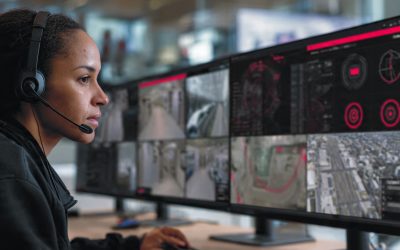In an era where security is paramount, ensuring that Closed-Circuit Television (CCTV) systems comply with the National Defence Authorisation Act (NDAA) is crucial for many organisations. The NDAA prohibits the use of certain telecommunications and video surveillance services or equipment from specific companies, primarily those linked to foreign adversaries. This article aims to provide a comprehensive guide on how to check CCTV systems for NDAA compliance, ensuring that your security measures meet the necessary legal standards.
Understanding NDAA Compliance
The NDAA was established to protect national security interests and includes provisions that affect various sectors, including security technology. While it is an American organisation, their strict security standards are helpful when considering purchases in Australia. For organisations operating in Australia or those that have dealings with the United States, understanding the implications of NDAA compliance is essential.
What is NDAA Compliance?
NDAA compliance refers to adherence to the regulations set forth in the NDAA, particularly those concerning the procurement and use of surveillance equipment. The act specifically bans the use of equipment from companies such as Huawei and ZTE, which are deemed to pose a national security risk. Compliance ensures that organisations are not inadvertently using technology that could jeopardise their security posture.
Why is NDAA Compliance Important?
Ensuring NDAA compliance is not merely a matter of legal obligation; it also protects organisations from potential security vulnerabilities. Especially for commercial security systems, following it is vital. Non-compliance can lead to severe consequences, including financial penalties, loss of contracts, and damage to reputation. Furthermore, using compliant technology enhances overall security by reducing the risk of surveillance breaches and data leaks.
Moreover, the implications of NDAA compliance extend beyond immediate security concerns. For organisations that engage in international trade or have partnerships with US-based companies, demonstrating compliance can be a vital factor in maintaining business relationships. As global supply chains become increasingly interconnected, the scrutiny on compliance with national security regulations only intensifies. Therefore, organisations must not only ensure that their technology is compliant but also that their suppliers and partners adhere to the same standards, creating a robust network of security that mitigates risks across the board.
Additionally, the landscape of technology and security is constantly evolving, with new threats emerging regularly. As such, staying updated on NDAA compliance requirements is crucial for organisations to remain proactive rather than reactive. This may involve regular audits of existing technology, training staff on compliance protocols, and engaging with legal experts to navigate the complexities of the regulations. By fostering a culture of compliance, organisations can not only safeguard their assets but also position themselves as responsible entities in an increasingly security-conscious market.
Steps to Check CCTV and Security Systems for NDAA Compliance
To ensure that your CCTV systems are compliant with NDAA regulations, a systematic approach is required to assess all components, including those connected to a back-to-base monitoring centre, for compliance. Below are the steps to effectively assess your systems.
1. Identify the Equipment Used
The first step in checking for NDAA compliance is to create a comprehensive inventory of all CCTV equipment in use. This includes cameras, recording devices, and any associated software. It is essential to document the make, model, and manufacturer of each piece of equipment.
Once the inventory is complete, cross-reference the manufacturers against the list of banned entities as outlined in the NDAA. This list is updated periodically, so it is important to ensure that the most current information is being used.
2. Review Purchase Records
Next, review the purchase records for all CCTV equipment. This includes invoices, contracts, and any procurement documents. It is crucial to ascertain that all equipment, including alarm monitoring systems, was sourced from compliant suppliers. If any equipment was procured from a non-compliant source, steps must be taken to replace it with compliant alternatives.
Additionally, consider the procurement process itself. Ensure that your organisation has established guidelines that prioritise NDAA compliance when sourcing new equipment. This proactive approach can prevent future compliance issues.
3. Conduct a Risk Assessment
After identifying and reviewing the equipment, conduct a thorough risk assessment. This involves evaluating the potential risks associated with using non-compliant security monitoring systems. Consider the implications of a data breach or surveillance failure due to compromised technology.
Engage with cybersecurity professionals to gain insights into the vulnerabilities that may arise from non-compliance. Their expertise can help in understanding the broader implications for your organisation’s security framework.
Finding Compliant CCTV Solutions
Once non-compliant equipment has been identified, the next step is to find suitable replacements. Fortunately, there are numerous manufacturers that provide NDAA-compliant CCTV systems incorporating the latest technology. Here are some tips for sourcing compliant solutions.
1. Research Reputable Manufacturers and Professional Security Service Providers
Begin by researching manufacturers known for their commitment to NDAA compliance. Look for companies that have been transparent about their compliance status and can provide documentation to support their claims. Many reputable manufacturers will have dedicated sections on their websites detailing their compliance with various regulations, including the NDAA.
Additionally, consider reaching out to industry associations or groups that focus on security technology. These organisations often have resources and recommendations for compliant manufacturers that offer comprehensive security solutions, including base monitoring services.
2. Request Compliance Documentation
When engaging with potential suppliers, always request compliance documentation. This should include certification that the equipment meets NDAA standards. A reputable supplier will readily provide this information, ensuring that you can make informed decisions about your purchases.
Furthermore, consider establishing a checklist of compliance criteria that suppliers must meet. This checklist should ensure that the equipment is compatible with control room operations, streamlining the procurement process and ensuring that all equipment sourced is compliant from the outset.
3. Evaluate the Technology
Before finalising any purchase, evaluate the technology itself. Ensure that it not only meets NDAA compliance but also aligns with your organisation’s security needs. Consider factors such as image quality, storage capabilities, and integration with existing systems. Consider the benefits of wired vs unwired solutions for commercial security.
Conducting a pilot test of the equipment can be beneficial. This allows for an assessment of the technology in a real-world setting, ensuring it meets the required standards and is compatible with the NBN network before full deployment.
Implementing Compliance Training
Having compliant equipment is only part of the equation. Ensuring that staff, including security professionals, are trained to understand and uphold NDAA compliance is equally important. Implementing a training programme can foster a culture of compliance within the organisation.
1. Develop Training Materials
Create training materials that clearly outline the importance of NDAA compliance and the specific regulations that apply to your organisation. This should include information on the potential risks associated with non-compliance, the steps taken to ensure adherence, and how to respond to compliance issues.
Utilise various formats for training materials, such as presentations, handouts, and online modules. This variety can cater to different learning styles and enhance understanding among staff.
2. Conduct Regular Training Sessions
Regular training sessions should be scheduled to keep staff updated on compliance requirements and any changes to the NDAA. This ensures that everyone remains informed and vigilant regarding compliance issues.
Consider incorporating case studies or real-world examples of compliance failures to illustrate the importance of adhering to NDAA regulations. These case studies should also show how compliance issues were responded to, fostering engagement and encouraging proactive compliance behaviour.
3. Establish a Compliance Team and Control Room
Establishing a dedicated compliance team can further reinforce the importance of NDAA adherence within the organisation. This team can be responsible for monitoring compliance status, conducting audits, and addressing any issues that arise.
Having a designated team also ensures that there is accountability and oversight regarding compliance efforts, unlike self-monitoring which requires individual vigilance and responsiveness. This professional oversight can lead to a more robust security posture and a greater commitment to upholding NDAA standards.
Ongoing Monitoring and Review
Compliance is not a one-time effort; it requires ongoing monitoring and review. Back-to-base security needs ongoing supervision. Establishing a framework for regular assessments can help maintain NDAA compliance over time.
1. Schedule Regular Audits
Conduct regular audits of your CCTV systems to ensure continued compliance with NDAA regulations. This should include reviewing equipment inventories, purchase records, training documentation, and alarm monitoring systems for compliance. Regular audits can help identify any potential compliance gaps before they become significant issues.
Consider engaging third-party auditors for an impartial assessment. Their expertise can provide valuable insights and recommendations for improving compliance efforts. Consider consulting professional commercial security installation services to ensure 100% compliance,
2. Stay Informed on Regulatory Changes
Regulations can change, and staying informed about updates to the NDAA is crucial. Subscribe to relevant industry publications, join professional organisations, and participate in forums to keep abreast of any changes that may affect compliance. Additionally, subscribing to updates on your mobile phone can help you stay informed about regulatory changes in real-time.
Being proactive in understanding regulatory changes can help your organisation adapt quickly and maintain compliance without disruption.
3. Foster a Culture of Compliance Among Security Professionals
Finally, fostering a culture of compliance within the organisation is essential. Ensure that all security systems are part of the compliance efforts. Encourage open communication about compliance issues and empower staff to report any concerns. Recognising and rewarding compliance efforts can also motivate staff to prioritise NDAA adherence.
By embedding compliance into the organisational culture, it becomes a shared responsibility, further enhancing the security framework and reducing risks associated with non-compliance.
Conclusion
Ensuring that CCTV systems are compliant with NDAA regulations is a critical aspect of maintaining security in both homes and businesses. By understanding the requirements, systematically assessing equipment, sourcing compliant solutions, and fostering a culture of compliance, organisations can improve their commercial security and protect themselves from potential risks associated with non-compliance. Regular monitoring and training will ensure that compliance remains a priority, ultimately contributing to a more secure environment.










